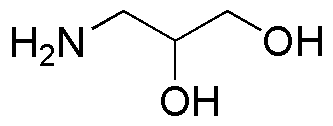Isoserinol is widely utilized in research focused on:
- Pharmaceutical Development: Its unique structure makes it a valuable intermediate in the synthesis of various pharmaceuticals, enhancing the efficacy of drug formulations.
- Cosmetic Formulations: Used in skincare products, it acts as a moisturizing agent, improving skin hydration and texture, which is crucial for the beauty industry.
- Biochemical Research: Serves as a reagent in biochemical assays, aiding researchers in studying enzyme activities and metabolic pathways.
- Agricultural Chemicals: Employed in the formulation of pesticides and herbicides, it helps in developing more effective and environmentally friendly agricultural products.
- Food Industry: Used as a food additive, it can enhance flavor profiles and improve the stability of food products, catering to the needs of food manufacturers.
General Information
Properties
Safety and Regulations
Applications
Isoserinol is widely utilized in research focused on:
- Pharmaceutical Development: Its unique structure makes it a valuable intermediate in the synthesis of various pharmaceuticals, enhancing the efficacy of drug formulations.
- Cosmetic Formulations: Used in skincare products, it acts as a moisturizing agent, improving skin hydration and texture, which is crucial for the beauty industry.
- Biochemical Research: Serves as a reagent in biochemical assays, aiding researchers in studying enzyme activities and metabolic pathways.
- Agricultural Chemicals: Employed in the formulation of pesticides and herbicides, it helps in developing more effective and environmentally friendly agricultural products.
- Food Industry: Used as a food additive, it can enhance flavor profiles and improve the stability of food products, catering to the needs of food manufacturers.
Documents
Safety Data Sheets (SDS)
The SDS provides comprehensive safety information on handling, storage, and disposal of the product.
Product Specification (PS)
The PS provides a comprehensive breakdown of the product’s properties, including chemical composition, physical state, purity, and storage requirements. It also details acceptable quality ranges and the product's intended applications.
Certificates of Analysis (COA)
Search for Certificates of Analysis (COA) by entering the products Lot Number. Lot and Batch Numbers can be found on a product’s label following the words ‘Lot’ or ‘Batch’.
*Catalog Number
*Lot Number
Certificates Of Origin (COO)
This COO confirms the country where the product was manufactured, and also details the materials and components used in it and whether it is derived from natural, synthetic, or other specific sources. This certificate may be required for customs, trade, and regulatory compliance.
*Catalog Number
*Lot Number
Safety Data Sheets (SDS)
The SDS provides comprehensive safety information on handling, storage, and disposal of the product.
DownloadProduct Specification (PS)
The PS provides a comprehensive breakdown of the product’s properties, including chemical composition, physical state, purity, and storage requirements. It also details acceptable quality ranges and the product's intended applications.
DownloadCertificates of Analysis (COA)
Search for Certificates of Analysis (COA) by entering the products Lot Number. Lot and Batch Numbers can be found on a product’s label following the words ‘Lot’ or ‘Batch’.
*Catalog Number
*Lot Number
Certificates Of Origin (COO)
This COO confirms the country where the product was manufactured, and also details the materials and components used in it and whether it is derived from natural, synthetic, or other specific sources. This certificate may be required for customs, trade, and regulatory compliance.

